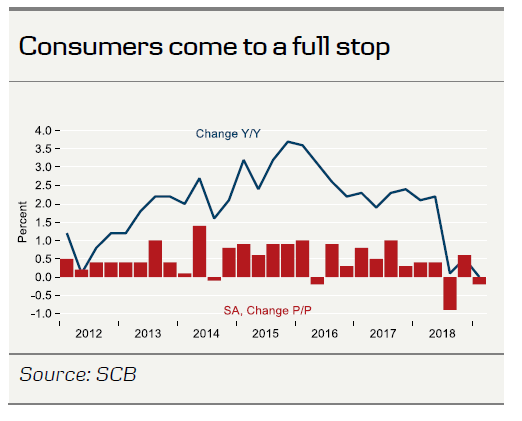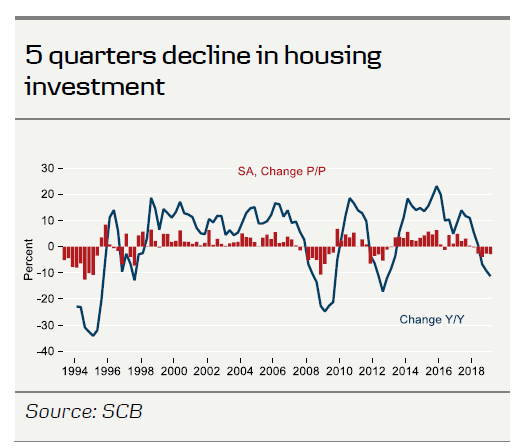GDP Q1 19. At face value, Q1 GDP was considerably stronger than our projection, coming in at 0.6% q/q/2.6% y/y (our estimate was -0.3% q/q/1.3% y/y).
Underneath the surface. We argue that demand was undoubtedly on the soft side of what we thought, For instance, consumer spending fell (0.2%) from Q4; the same was the case for fixed investments (down 0.4% q/q). In both cases, we were looking for small increases. Exports came in somewhat on the high side of our estimate but the big reason for higher GDP was a considerably softer number for imports, which slumped (down 0.7%). Overall, this is a weak GDP report from a domestic demand perspective and this is reflected in a steep decline in imports, so while exports held up reasonably well, the result is an OK GDP number.
Other observations. (1) Consumer spending is remarkably weak registering a quarteron- quarter decline and being flat in year-on-year terms. Spending held up well until Q2 18 but then something happened. Then again, considering that consumer confidence has been surprisingly weak of late (yesterday’s number was a multi-year low), maybe this is not so strange after all. (2) The fixed investment cycle has no doubt peaked. Part of that story relates to housing construction, which on a quarterly basis registered the fifth consecutive decline. The year-on-year rate in Q1 was -11.3% (the peak was +23.2% in Q4 15).
Riksbank. The GDP figure was higher than the Riksbank forecast of 1.7% but we feel sure that it will make a similar analysis to us. Domestic demand is weakening markedly and this is why import demand has slumped. We would say that to the extent the Riksbank has had some concerns about downside growth risk, it should be more worried now.
SEK. For the SEK, this is not a game changer, in our view. The knee-jerk reaction was to send the cross to 10.65ish, but given the details, it is fair that the move reversed to pre-data levels. As it was mainly net exports that surprised, one could think that it is an SEK effect. However, given that it was due to weaker services imports and weaker goods exports, we are not so sure about this.














